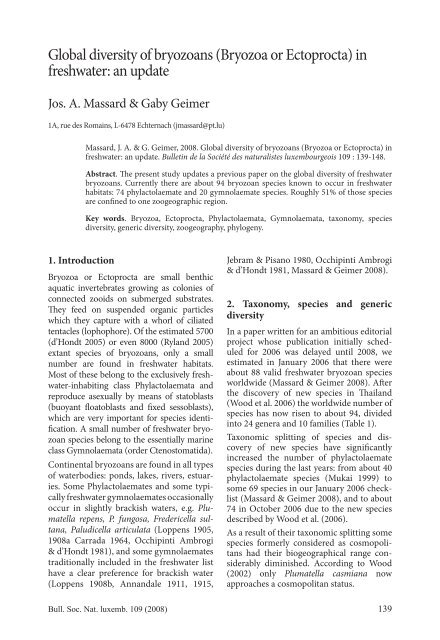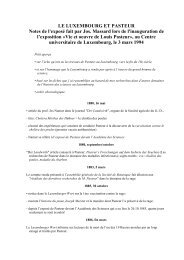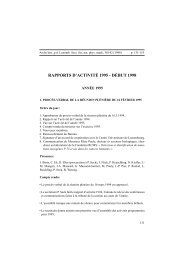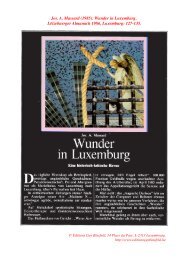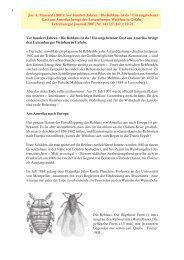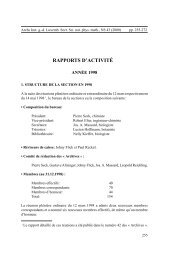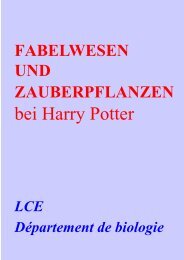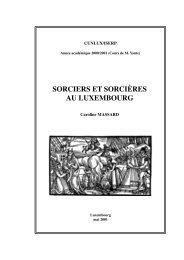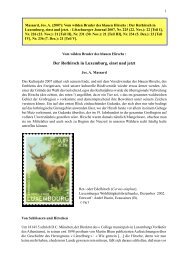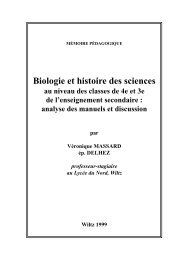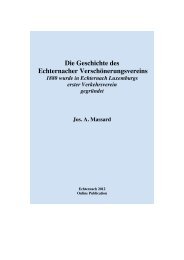Global diversity of bryozoans (Bryozoa or Ectoprocta) - Jos A. Massard
Global diversity of bryozoans (Bryozoa or Ectoprocta) - Jos A. Massard
Global diversity of bryozoans (Bryozoa or Ectoprocta) - Jos A. Massard
You also want an ePaper? Increase the reach of your titles
YUMPU automatically turns print PDFs into web optimized ePapers that Google loves.
<strong>Global</strong> <strong>diversity</strong> <strong>of</strong> <strong>bryozoans</strong> (<strong>Bryozoa</strong> <strong>or</strong> <strong>Ectoprocta</strong>) in<br />
freshwater: an update<br />
<strong>Jos</strong>. A. <strong>Massard</strong> & Gaby Geimer<br />
1A, rue des Romains, L-6478 Echternach (jmassard@pt.lu)<br />
1. Introduction<br />
<strong>Massard</strong>, J. A. & G. Geimer, 2008. <strong>Global</strong> <strong>diversity</strong> <strong>of</strong> <strong>bryozoans</strong> (<strong>Bryozoa</strong> <strong>or</strong> <strong>Ectoprocta</strong>) in<br />
freshwater: an update. Bulletin de la Société des naturalistes luxembourgeois 109 : 139-148.<br />
Abstract. The present study updates a previous paper on the global <strong>diversity</strong> <strong>of</strong> freshwater<br />
<strong>bryozoans</strong>. Currently there are about 94 bryozoan species known to occur in freshwater<br />
habitats: 74 phylactolaemate and 20 gymnolaemate species. Roughly 51% <strong>of</strong> those species<br />
are confined to one zoogeographic region.<br />
Key w<strong>or</strong>ds. <strong>Bryozoa</strong>, <strong>Ectoprocta</strong>, Phylactolaemata, Gymnolaemata, taxonomy, species<br />
<strong>diversity</strong>, generic <strong>diversity</strong>, zoogeography, phylogeny.<br />
<strong>Bryozoa</strong> <strong>or</strong> <strong>Ectoprocta</strong> are small benthic<br />
aquatic invertebrates growing as colonies <strong>of</strong><br />
connected zooids on submerged substrates.<br />
They feed on suspended <strong>or</strong>ganic particles<br />
which they capture with a wh<strong>or</strong>l <strong>of</strong> ciliated<br />
tentacles (lophoph<strong>or</strong>e). Of the estimated 5700<br />
(d’Hondt 2005) <strong>or</strong> even 8000 (Ryland 2005)<br />
extant species <strong>of</strong> <strong>bryozoans</strong>, only a small<br />
number are found in freshwater habitats.<br />
Most <strong>of</strong> these belong to the exclusively freshwater-inhabiting<br />
class Phylactolaemata and<br />
reproduce asexually by means <strong>of</strong> statoblasts<br />
(buoyant floatoblasts and fixed sessoblasts),<br />
which are very imp<strong>or</strong>tant f<strong>or</strong> species identification.<br />
A small number <strong>of</strong> freshwater bryozoan<br />
species belong to the essentially marine<br />
class Gymnolaemata (<strong>or</strong>der Ctenostomatida).<br />
Continental <strong>bryozoans</strong> are found in all types<br />
<strong>of</strong> waterbodies: ponds, lakes, rivers, estuaries.<br />
Some Phylactolaemates and some typically<br />
freshwater gymnolaemates occasionally<br />
occur in slightly brackish waters, e.g. Plumatella<br />
repens, P. fungosa, Fredericella sultana,<br />
Paludicella articulata (Loppens 1905,<br />
1908a Carrada 1964, Occhipinti Ambrogi<br />
& d’Hondt 1981), and some gymnolaemates<br />
traditionally included in the freshwater list<br />
have a clear preference f<strong>or</strong> brackish water<br />
(Loppens 1908b, Annandale 1911, 1915,<br />
Jebram & Pisano 1980, Occhipinti Ambrogi<br />
& d’Hondt 1981, <strong>Massard</strong> & Geimer 2008).<br />
2. Taxonomy, species and generic<br />
<strong>diversity</strong><br />
In a paper written f<strong>or</strong> an ambitious edit<strong>or</strong>ial<br />
project whose publication initially scheduled<br />
f<strong>or</strong> 2006 was delayed until 2008, we<br />
estimated in January 2006 that there were<br />
about 88 valid freshwater bryozoan species<br />
w<strong>or</strong>ldwide (<strong>Massard</strong> & Geimer 2008). After<br />
the discovery <strong>of</strong> new species in Thailand<br />
(Wood et al. 2006) the w<strong>or</strong>ldwide number <strong>of</strong><br />
species has now risen to about 94, divided<br />
into 24 genera and 10 families (Table 1).<br />
Taxonomic splitting <strong>of</strong> species and discovery<br />
<strong>of</strong> new species have significantly<br />
increased the number <strong>of</strong> phylactolaemate<br />
species during the last years: from about 40<br />
phylactolaemate species (Mukai 1999) to<br />
some 69 species in our January 2006 checklist<br />
(<strong>Massard</strong> & Geimer 2008), and to about<br />
74 in October 2006 due to the new species<br />
described by Wood et al. (2006).<br />
As a result <strong>of</strong> their taxonomic splitting some<br />
species f<strong>or</strong>merly considered as cosmopolitans<br />
had their biogeographical range considerably<br />
diminished. Acc<strong>or</strong>ding to Wood<br />
(2002) only Plumatella casmiana now<br />
approaches a cosmopolitan status.<br />
Bull. Soc. Nat. luxemb. 109 (2008) 139
Table 1. Numeric data f<strong>or</strong> the different taxa <strong>of</strong> freshwater <strong>Bryozoa</strong>.<br />
Taxon Families Genera Species<br />
Gymnolaemata Allman, 1856 5 8 20<br />
Vict<strong>or</strong>ellidae Hincks, 1880 4 8<br />
Bulbella Braem, 1951 1<br />
Sinep<strong>or</strong>tella Wood & Marsh, 1996 1<br />
Tanganella Braem, 1951 2<br />
Vict<strong>or</strong>ella Saville Kent, 1870 a<br />
4<br />
Pottsiellidae Braem, 1940 1 1<br />
Pottsiella Kraepelin, 1887 1<br />
Paludicellidae Allman, 1885 1 2<br />
Paludicella Gervais 1836 2<br />
Arachnidiidae Hincks, 1877 1 1<br />
Arachnoidea (Mo<strong>or</strong>e, 1903) 1<br />
Hislopiidae Jullien, 1885 1 8<br />
Hislopia Carter, 1858 b 8<br />
Phylactolaemata Allman, 1856 5 16 74<br />
Fredericellidae Hyatt, 1868 2 6<br />
Fredericella Gervais 1838 5<br />
Internectella Gruncharova, 1971 c<br />
1<br />
Plumatellidae Allman, 1856 9 59<br />
Afrindella Annandale, 1912 d<br />
3<br />
Australella Annandale, 1910 1<br />
Gelatinella T<strong>or</strong>iumi, 1955 1<br />
Hyalinella Jullien, 1885 e<br />
5<br />
Plumatella Lamarck, 1816 f<br />
40<br />
Stephanella Oka, 1908 g<br />
1<br />
Stolella Annandale, 1909 2<br />
Swarupella Shrivastava, 1981 3<br />
Varunella Wiebach, 1974 3<br />
Pectinatellidae Lacourt, 1968 h<br />
1 1<br />
Pectinatella Leidy, 1851 1<br />
Cristatellidae Allman, 1856 1 1<br />
Cristatella Cuvier, 1798 1<br />
Lophopodidae Rogick, 1935 3 7<br />
Asajirella Oda & Mukai, 1989 1<br />
Lophopodella Rousselet, 1904 5<br />
Lophopus Dum<strong>or</strong>tier, 1835 1<br />
<strong>Ectoprocta</strong> Nitsche, 1870 10 24 94<br />
a Wood et al. (2006) consider Vict<strong>or</strong>ella bengalensis Annandale, 1908 as a synonym <strong>of</strong> Vict<strong>or</strong>ella pavida,<br />
whereas in our checklist they are listed as distinct species.<br />
b Incl. N<strong>or</strong>odonia Jullien, 1880 and Echinella K<strong>or</strong>otnev, 1901.<br />
c Combines traits <strong>of</strong> the Fredericellidae and the Plumatellidae; closer to Plumatellidae acc<strong>or</strong>ding to<br />
Gruncharova [Grancarova] (1971); placed among the latter by Vinogradov (2004), and among the<br />
Fredericellidae by Wood & Okamura (2005).<br />
d Listed as Afrindella Wiebach, 1964 by Bock (2005) and in his wake by <strong>Massard</strong> & Geimer (2008).<br />
In fact the taxon Afrindella was introduced as a new subgenus by Annandale in 1912 (Annandale &<br />
Kemp 1912) with Plumatella (Afrindella) tanganyikae (Rousselet, 1907) as type species; it was raised<br />
to genus level by Marcus (1942) and Wiebach (1964), the latter m<strong>or</strong>eover defining a new type species,<br />
namely Afrindella philippinensis Kraepelin, 1887 (= Plumatella philippinensis Kraepelin, 1887). Lacourt<br />
(1968) does not take into account the genus Afrindella; he calls Plumatella tanganyikae Rousselet, 1907<br />
a doubtful species, and considers Plumatella (Afrindella) testudinicola Annandale, 1912 as Fredericella<br />
140 Bull. Soc. Nat. luxemb. 109 (2008)
australiensis Goddard, 1909, erroneously, as pointed out by Wiebach (1974).<br />
e Placed by Vinogradov (2004) in a new family accepted by Wood et al. (2006): Hyalinellidae Vinogradov,<br />
2004.<br />
f Vinogradov (2004) has introduced the new genus Leptoblastella with the species: Leptoblastella<br />
casmiana (= Plumatella casmiana Oka, 1908).<br />
g One single known species (Stephanella hina Oka, 1908) f<strong>or</strong> which Lacourt (1968) created the family <strong>of</strong><br />
the Stephanellidae, whereas f<strong>or</strong> other bryozoologists Stephanella remained a member the Plumatellidae.<br />
Mukai (1990, 1999), Vinogradov (2004) and Okuyama et al. (2006) consider Lacourt’s family as valid.<br />
h In spite <strong>of</strong> Lacourt (1968) many auth<strong>or</strong>s continued to consider Pectinatella as belonging to the<br />
Lophopodidae (Bushnell 1973, 1974, Geimer & <strong>Massard</strong> 1986, Wood 1989). Wood & Okamura (2005)<br />
now accept Lacourt’s Pectinatellidae. Mukai (1999) estimated that the genera Pectinatella (with the<br />
single species P. magnifica) and Cristatella (with the single species C. mucedo) should be united in the<br />
family Cristatellidae; the study <strong>of</strong> Okuyama et al. (2006) tends to c<strong>or</strong>rob<strong>or</strong>ate this idea not adopted in<br />
the present table f<strong>or</strong> practical and hist<strong>or</strong>ical reasons.<br />
3. Zoogeography and distribution<br />
The zoogeographical distribution <strong>of</strong> freshwater<br />
<strong>bryozoans</strong> has been analysed by Lacourt<br />
(1968), Bushnell (1973), Rao (1992) and<br />
Wood (2002). The checklist compiled f<strong>or</strong><br />
the present paper includes a total <strong>of</strong> 94 species<br />
(Tables 2-4, Fig. 1). F<strong>or</strong>ty-nine species<br />
(52,1 %) are limited to one zoogeographic<br />
region: 13 gymnolaemates (13.8%) and 36<br />
phylactolaemates (38.3%). Twenty-four <strong>of</strong><br />
these 49 species are known only from a very<br />
restricted area (one <strong>or</strong> two sites).<br />
The alleged European occurrence <strong>of</strong> Plumatella<br />
javanica Kraepelin, 1906 mentioned<br />
Table 2. Number <strong>of</strong> genera rec<strong>or</strong>ded in the various zoogeographic regions.<br />
by Bushnell (1973) and Wiebach & d’Hondt<br />
(1978) is in fact due to a mistake made by<br />
Bushnell when drawing his distribution<br />
maps (<strong>Massard</strong> & Geimer 2005). Lacourt’s<br />
rec<strong>or</strong>d <strong>of</strong> Fredericella australiensis in Belgium<br />
(Lacourt 1968) is probably erroneous<br />
(Wood & Okamura 2004, <strong>Massard</strong> &<br />
Geimer 2005); its alleged Russian occurrences<br />
(Lacourt 1968, Vinogradov 2006)<br />
have to be confirmed, and so has the identification<br />
<strong>of</strong> Stolella indica rep<strong>or</strong>ted from the<br />
Rhine by Franz (1992).<br />
The numerous rep<strong>or</strong>ts <strong>of</strong> Plumatella fruticosa<br />
from South America and the Indian area are<br />
Taxon PA NA NT AT OL AU PAC W<strong>or</strong>ld<br />
Gymnolaemata 6 4 4 2 3 2 - 8<br />
Vict<strong>or</strong>ellidae 3 2 1 1 1 1 - 4<br />
Pottsiellidae - 1 1 - - - - 1<br />
Paludicellidae 1 1 1 - 1 1 - 1<br />
Arachnidiidae 1 - - 1 - - - 1<br />
Hislopiidae 1 - 1 - 1 - - 1<br />
Phylactolaemata 13 a 9 a 6 8 a 14 4 1 16<br />
Fredericellidae 2 1 1 1 2 1 - 2<br />
Plumatellidae b 6 4 3 6 9 2 1 9<br />
Pectinatellidae 1 1 1 - 1 - - 1<br />
Cristatellidae 1 1 - - - - - 1<br />
Lophopodidae 3 2 1 1 2 1 - 3<br />
Total 19 13 10 10 17 6 1 24<br />
PA: Palaearctic; NA: Nearctic; NT: Neotropical; AT: Africotropical; OL: Oriental; AU: Australasian;<br />
PAC: Pacific Oceanic Islands.<br />
a Including Stolella (occurrence/identification to be confirmed).<br />
b Including Stephanella and Hyalinella.<br />
Bull. Soc. Nat. luxemb. 109 (2008) 141
Table 3. Zoogeographical distribution (number <strong>of</strong> species per family in the different zoogeographic<br />
regions).<br />
Taxon PA NA NT AT OL AU PAC W<strong>or</strong>ld<br />
Gymnolaemata 10 (6) 4 (1) 6 (1) 2 (1) 8 (4) 2 0 (0) 20 (13)<br />
Vict<strong>or</strong>ellidae 5 (4) 2 (1) 1 1 (1) 2 (1) 1 - 8 (7)<br />
Pottsiellidae - 1 1 - - - - 1 (0)<br />
Paludicellidae 1 1 2 - 1 1 - 2 (0)<br />
Arachnidiidae 1 - - 1 - - - 1 (0)<br />
Hislopiidae 3 (2) - 2 (1) - 5 (3) - - 8 (6)<br />
Phylactolaemata 34 (5) 28 (4) 24 (7) 20 (4) 39 (14) 14 (2) 2 (0) 74 (36)<br />
Fredericellidae 4 4 3 (1) 2 4 2 - 6 (1)<br />
Plumatellidae 24 b (5) 20 b (4) 19 c (6) 14 b (3) 30 (13) 11 (2) 2 59 (33)<br />
Pectinatellidae 1 1 1 - 1 - - 1 (0)<br />
Cristatellidae 1 1 - - - - - 1 (0)<br />
Lophopodidae 4 2 1 4 d (1) 4 d (1) 1 - 7 (2)<br />
Total 44 a (11) 32 b (5) 30 c (8) 22 bd (5) 47 cd (18) 16 (2) 2 (0) 94 (49)<br />
PA: Palaearctic; NA: Nearctic; NT: Neotropical; AT: Africotropical; OL: Oriental; AU: Australasian;<br />
PAC: Pacific Oceanic Islands. W<strong>or</strong>ld = total <strong>of</strong> species per taxon (one given species <strong>of</strong>ten occurring in<br />
m<strong>or</strong>e than one zoogeographic region, the sum <strong>of</strong> the species numbers <strong>of</strong> the different regions n<strong>or</strong>mally<br />
exceeds the total number <strong>of</strong> species <strong>of</strong> the family). Number in brackets = number <strong>of</strong> species confined<br />
to one zoogeographic region only.<br />
a Including Fredericella australiensis, Plumatella javanica, Stolella indica (occurrence/identification to<br />
be confirmed).<br />
b Including Stolella indica Annandale, 1909 (occurrence/identification to be confirmed).<br />
c Not including Plumatella fruticosa (occurrence/identification to be confirmed).<br />
d Including Lophopodella stuhlmanni Kraepelin, 1914 (doubtful species, considered as L. carteri by<br />
T<strong>or</strong>iumi 1974) and Vict<strong>or</strong>ella bengalensis Annandale, 1908 (considered as synonym <strong>of</strong> V. pavida by<br />
Wood et al. 2006).<br />
Table 4. Checklist and zoogeographical distribution <strong>of</strong> the considered freshwater bryozoan species.<br />
Zoogeographic region<br />
Gymnolaemata<br />
PAe PAa PA NA NT AT OL AU PAC<br />
Arachnoidea raylankesteri (Mo<strong>or</strong>e, 1903) x x x<br />
Bulbella abscondita Braem, 1951 x x<br />
Hislopia cambodgiensis (Jullien, 1885) x x x<br />
Hislopia c<strong>or</strong>deroi Mañé-Garzón, 1959 x<br />
Hislopia lacustris Carter, 1858 x x<br />
Hislopia malayensis Annandale, 1916 x<br />
Hislopia monilif<strong>or</strong>mis (Annandale, 1911) x<br />
Hislopia natans Wood et al., 2006 x<br />
Hislopia placoides (K<strong>or</strong>otnev, 1901) x x<br />
Hislopia sinensis (Jullien, 1880) x x<br />
Paludicella articulata (Ehrenberg, 1831) x x x x x x<br />
Paludicella pentagonalis Annandale, 1916 x x<br />
Pottsiella erecta (Potts, 1884) x x<br />
Sinep<strong>or</strong>tella f<strong>or</strong>besi Wood & Marsh, 1996 x<br />
Tanganella muelleri (Kraepelin, 1887) x x<br />
Tanganella symbiotica (Rousselet, 1907) x<br />
Vict<strong>or</strong>ella bengalensis Annandale, 1908 x<br />
142 Bull. Soc. Nat. luxemb. 109 (2008)
Zoogeographic region PAe PAa PA NA NT AT OL AU PAC<br />
Vict<strong>or</strong>ella bergi Abrikosov, 1959 x x<br />
Vict<strong>or</strong>ella continentalis Braem, 1911 x x<br />
Vict<strong>or</strong>ella pavida Saville Kent, 1870<br />
Phylactolaemata<br />
x x x x x x?<br />
Afrindella philippinensis (Kraepelin, 1887) x x x<br />
Afrindella tanganyikae (Rousselet, 1907) x<br />
Afrindella testitudinicola (Annandale, 1912) x<br />
Asajirella gelatinosa (Oka, 1891) x x x x<br />
Australella indica Annandale, 1915 x x x x<br />
Cristatella mucedo Cuvier, 1798 x x x x ?<br />
Fredericella australiensis Goddard, 1909 x? x? x? x x x x<br />
Fredericella browni (Rogick, 1945) x x<br />
Fredericella crenulata (Reymond-Marcus, 1946) x<br />
Fredericella indica Annandale, 1909 x x x x x<br />
Fredericella sultana (Blumenbach, 1779) x x x x x x x<br />
Gelatinella toanensis (Hozawa & T<strong>or</strong>iumi, 1940) x x a a x a<br />
Hyalinella diwanensis Rao et al., 1985 x<br />
Hyalinella iheringi Meissner, 1893 x<br />
Hyalinella lendenfeldi (Ridley, 1886) x x<br />
Hyalinella minuta (T<strong>or</strong>iumi, 1941) x x x<br />
Hyalinella punctata (Hancock, 1850) x x x x x x? x?<br />
Internectella bulgarica Gruncharova, 1971 x x x<br />
Lophopodella capensis (Sollas, 1980) x x x<br />
Lophopodella carteri (Hyatt, 1866) x x x x x x x<br />
Lophopodella pectinatellif<strong>or</strong>mis Lacourt, 1959 x<br />
Lophopodella stuhlmanni Kraepelin, 1914 x x<br />
Lophopodella thomasi Rousselet, 1904 x<br />
Lophopus crystallinus Pallas, 1768 x x x x<br />
Pectinatella magnifica (Leidy, 1851) x x x x x x<br />
Plumatella agilis (Marcus, 1942) x x x x<br />
Plumatella angarensis Vinogradov, 1985 x x<br />
Plumatella bigemmis Annandale, 1919 x<br />
Plumatella bombayensis Annandale, 1908 x x x<br />
Plumatella bushnelli Wood, 2001 x x<br />
Plumatella carvalhoi (Marcus, 1942) x<br />
Plumatella casmiana Oka, 1907 x x x x x x x<br />
Plumatella chulabh<strong>or</strong>nae Wood et al., 2006 x<br />
Plumatella crassipes Wiebach, 1974 x<br />
Plumatella emarginata Allman, 1844 x x x x x x x x<br />
Plumatella evelinae (Marcus, 1941) x x x?<br />
Plumatella fruticosa Allman, 1844 x x x x ? ?<br />
Plumatella fungosa (Pallas, 1768) x x x x ? x<br />
Plumatella ganapati Rao et al., 1985 x<br />
Plumatella geimermassardi Wood & Okamura, 2004 x x<br />
Plumatella javanica Kraepelin, 1906 x? x? x? x? x? x x?<br />
Plumatella longigemmis (Annandale, 1915) x x? x x<br />
Plumatella marcusi Wiebach, 1970 x<br />
Plumatella marlieri Wiebach, 1970 x<br />
Plumatella mongoliensis Vinogradov, 1985 x x<br />
Plumatella mukaii Wood, 2001 x x x x x<br />
Bull. Soc. Nat. luxemb. 109 (2008) 143
Zoogeographic region PAe PAa PA NA NT AT OL AU PAC<br />
Plumatella nitens Wood, 1996 x<br />
Plumatella nodulosa Wood, 2001 x<br />
Plumatella <strong>or</strong>bisperma Kellicott, 1882 x<br />
Plumatella osburni (Rogick & Brown, 1942) x x x<br />
Plumatella patagonica Wiebach, 1974 x<br />
Plumatella recluse Smith, 1992 x<br />
Plumatella repens (Linné, 1758) x x x x x x x x<br />
Plumatella reticulata Wood, 1988 x x x x x<br />
Plumatella rieki Wood, 1998 x<br />
Plumatella rugosa (Wood et al., 1998) x x x x<br />
Plumatella sedimentata Vinogradov, 1985 x x<br />
Plumatella siamensis Wood et al., 2006 x<br />
Plumatella sibiriensis Vinogradov, 1985 x x<br />
Plumatella similirepens Wood, 2001 x x x<br />
Plumatella siolii Wiebach, 1970 x<br />
Plumatella suwana Wood et al., 2006 x<br />
Plumatella vaihiriae (Hastings, 1929) x x x? x<br />
Plumatella velata Wood, 1998 x<br />
Plumatella v<strong>or</strong>stmani T<strong>or</strong>iumi, 1952 x x x<br />
Stephanella hina Oka, 1908 x x x x<br />
Stolella himalayana Annandale, 1911 x<br />
Stolella indica Annandale, 1909 x? x? x? x? x<br />
Swarupella andamanensis (Rao, 1961) x<br />
Swarupella divina Wood et al., 2006 x<br />
Swarupella kasetsartensis Wood et al., 2006 x<br />
Varunella c<strong>or</strong>onifera Wiebach, 1974 x<br />
Varunella gemmata Wiebach, 1976 x<br />
Varunella ind<strong>or</strong>ana Wiebach, 1974 x<br />
PA: Palaearctic (PAe: European part; PAa: Asian part); NA: Nearctic; NT: Neotropical; AT: Africotropical;<br />
OL: Oriental; AU: Australasian; PAC: Pacific Oceanic Islands.<br />
x : present.<br />
x? : mentioned in the literature, but occurrence/identification needs confirmation.<br />
? : doubtful (here considered as absent).<br />
a : absent (mentioned in the literature as the result <strong>of</strong> a misidentification).<br />
due to misidentifications and actually must<br />
be assigned to P. philippinensis (Lacourt<br />
1968). Wood confirms that P. fruticosa has<br />
not been found in India (Wood 2002, in litt.<br />
2006), so the rec<strong>or</strong>ds mentioned by Annandale<br />
(1911), Rao et al. (1985), Rao (1992)<br />
must be reconsidered. It should be noted<br />
that Rao et al. (1985) consider P. fruticosa as<br />
a synonym <strong>of</strong> P. philippinensis (listed as Afrindella<br />
philippinensis in our Table 4).<br />
A new phylactolaemate species, Plumatella<br />
geimermassardi, was recently described<br />
from Europe by Tim Wood and Beth Okamura<br />
(Wood & Okamura 2004). Internec-<br />
tella bulgarica hitherto only rep<strong>or</strong>ted from<br />
Bulgaria, has recently been identified in<br />
Thailand, where it is rather common (Wood<br />
& Okamura 2005, Wood et al. 2006). On<br />
the other hand, species f<strong>or</strong>merly unknown<br />
in Europe have been rec<strong>or</strong>ded there during<br />
the last years: Fredericella indica, Plumatella<br />
bombayensis, P. reticulata, P. rugosa, P. similirepens<br />
(<strong>Massard</strong> & Geimer 1995a, 1996,<br />
2005, Wood & Okamura 2005, Taticchi &<br />
Pieroni 2005, Taticchi et al. 2005, Taticchi et<br />
al. 2006).<br />
Some species may extend their distribution<br />
area thanks to long distance dispersal <strong>of</strong> sta-<br />
144 Bull. Soc. Nat. luxemb. 109 (2008)
Figure 1. Zoogeographical distribution map (species/<br />
genera per region; total: 94/24).<br />
PA: Palaearctic; NA: Nearctic; NT: Neotropical; AT:<br />
Africotropical; OL: Oriental; AU: Australasian; PAC:<br />
Pacific Oceanic Islands; ANT: Antarctic.<br />
toblasts by migrat<strong>or</strong>y waterfowl <strong>or</strong> by human<br />
activity (transp<strong>or</strong>t <strong>of</strong> statoblasts with aquatic<br />
plants, fish, navigation, etc.). In Europe<br />
this is the case, e.g., f<strong>or</strong> Plumatella casmiana<br />
(Geimer & <strong>Massard</strong> 1986, <strong>Massard</strong> &<br />
Geimer 1995b, <strong>Massard</strong> et al. 2002) and Pectinatella<br />
magnifica (d’Hondt & Condé 1996,<br />
Notteghem 1999, Rodriguez & Vergon 2002,<br />
<strong>Massard</strong> & Geimer 2002, 2005).<br />
Some other species, like Lophopus crystallinus,<br />
may seem rare because they are <strong>of</strong>ten<br />
overlooked (Hill et al. 2007). Possibly this is<br />
also true f<strong>or</strong> Fredericella indica in Europe:<br />
first rep<strong>or</strong>ted from Bavaria in 1994 (<strong>Massard</strong><br />
& Geimer 1995a, 1996), this pretended<br />
‘American’ species, appeared to be rather<br />
common in N<strong>or</strong>way (Økland & Økland<br />
2001); and recent data from the Sokli lacustrine<br />
sediments in n<strong>or</strong>thern Finland reveal<br />
the presence <strong>of</strong> F. indica in Europe some<br />
50000 years ago during the Tulppio Interstadial<br />
<strong>of</strong> the last glaciation (Helmens et al.<br />
2007).<br />
4. Palaeontology and phylogeny<br />
The most ancient <strong>bryozoans</strong> are marine<br />
stenolaemates from the Lower Ordovician<br />
(about 500 million years old) (Ryland 2005,<br />
Xia et al. 2007). Traces <strong>of</strong> fossil marine gymnolaemates<br />
are present in the Upper Ordovi-<br />
cian (McKinney & Jackson 1991). There are<br />
no fossil rec<strong>or</strong>ds <strong>of</strong> freshwater gymnolaemates.<br />
Fossil phylactolaemates are known<br />
only by their statoblasts; among the oldest<br />
are plumatellid statoblasts from the Upper<br />
Permian in the Asian part <strong>of</strong> the f<strong>or</strong>mer<br />
U.S.S.R. (Vinogradov 1991, 1996) and possibly<br />
pectinatellid statoblasts from the Upper<br />
Triassic Molteno F<strong>or</strong>mation in South Africa<br />
(Kohring & Hörnig 2002, Kohring & Pint<br />
2005).<br />
The phylogeny <strong>of</strong> the gymnolaemates is<br />
illustrated by Todd (2000). First drafts <strong>of</strong><br />
phylogenetic trees <strong>of</strong> the Phylactolaematea,<br />
which are phylogenetically older than the<br />
Gymnolaemata, have been provided by<br />
T<strong>or</strong>iumi (1956), Lacourt (1968) and Mukai<br />
(1999). Wood & L<strong>or</strong>e (2005) have shown<br />
that the gelatinous species (Lophopodidae,<br />
Pectinatellidae, Cristatellidae) are m<strong>or</strong>e<br />
primitive than the branching tubular species<br />
(Plumatellidae, Fredericellidae). Okuyama<br />
et al. (2006) suggest that the gelatinous,<br />
but branching Stephanella hina is the most<br />
basal phylactolaemate, and they supp<strong>or</strong>t the<br />
idea that it does not belong to the Plumatellidae,<br />
as still stated by Smith (1988), but to<br />
the separate family Stephanellidae created<br />
by Lacourt (1968) and accepted by Mukai<br />
(1990).<br />
References<br />
Annandale, N., 1911. Freshwater sponges,<br />
hydroids and polyzoa. The Fauna <strong>of</strong> British<br />
India including Ceylon and Burma: I-VIII,<br />
1-251.<br />
Annandale, N. & S. Kemp, 1912. Observations<br />
on the invertebrate fauna <strong>of</strong> the Kumaon<br />
Lakes, with special reference to the Sponges<br />
and Polyzoa. Rec<strong>or</strong>ds <strong>of</strong> the Indian Museum<br />
7: 129-145.<br />
Annandale, N., 1915. Fauna <strong>of</strong> the Chilka Lake.<br />
The Polyzoa <strong>of</strong> the lake and <strong>of</strong> brackish water<br />
in the Gangetic Delta. Memoirs <strong>of</strong> the Indian<br />
Museum 5: 119-133.<br />
Bock, P., 2005. Recent and Fossil <strong>Bryozoa</strong>. URL:<br />
http.civgeo.rmit.edu.au/bryozoa [download:<br />
16/01/2006]. Now: URL: http://www.bryozoa.net<br />
Bushnell, J.H., 1973. The freshwater <strong>Ectoprocta</strong>:<br />
a zoogeographical discussion. In: G.P. Larwood<br />
(ed.), Living and fossil <strong>Bryozoa</strong>: recent<br />
Bull. Soc. Nat. luxemb. 109 (2008) 145
advances in research. London & New Y<strong>or</strong>k,<br />
Academic Press: 503-521.<br />
Bushnell, J.H., 1974. <strong>Bryozoa</strong>ns (<strong>Ectoprocta</strong>).<br />
In: C.W. Hart & S.L.H. Fuller (eds), Pollution<br />
ecology <strong>of</strong> freshwater Invertebrates. New<br />
Y<strong>or</strong>k, London, Academic Press: 157-194.<br />
Carrada, G.C., 1964. Plumatella fungosa (Pallas)<br />
e Paludicella articulata (Ehrenberg) (<strong>Bryozoa</strong>)<br />
nello stagno di Cabras (Sardegna occ.).<br />
Natura 55: 157-165.<br />
Franz, H., 1992. Der Rhein und seine Besiedlung<br />
im Wandel: Schwebst<strong>of</strong>fzehrende Organismen<br />
(Hydrozoa, Kamptozoa und <strong>Bryozoa</strong>)<br />
als Indikat<strong>or</strong>en für den ökologischen Zustand<br />
eines Gewässers. Pollichia-Buch 25: 1-167.<br />
Geimer, G. & J.A. <strong>Massard</strong>, 1986. Les <strong>Bryozoa</strong>ires<br />
du Grand-Duché de Luxembourg et des<br />
régions limitrophes. Travaux Scientifiques du<br />
Musée d’Histoire Naturelle de Luxembourg 7:<br />
1-187.<br />
Gruncharova [Grancarova], T., 1971. Internectella<br />
bulgarica nov. gen., nov. sp., a new <strong>Bryozoa</strong><br />
species (<strong>Bryozoa</strong>, Phylactolaemata). Comptes<br />
rendus de l’Académie bulgare des Sciences 24<br />
(3): 361-364.<br />
Helmens, K.F., J.A.A. Bos, S. Engels, C.J. Van<br />
Meerbeeck, S.J.P. Bohncke, H. Renssen, O.<br />
Heiri, S.J. Brooks, H. Seppä, H.J.B. Birks & B.<br />
Wohlfarth, 2007. Present-day temperatures<br />
in n<strong>or</strong>thern Scandinavia during the last glaciation.<br />
Geology 35 (11): 987-990.<br />
Hill, S.L.L., C.D. Sayer, P.M. Hammond, V.K.<br />
Rimmer, T.A. Davidson, D.J. Hoare, A. Burgess<br />
& B. Okamura, 2007. Are rare species<br />
rare <strong>or</strong> just overloooked? Assessing the distribution<br />
<strong>of</strong> the freshwater bryozoan Lophopus<br />
crystallinus. Biological Conservation 135<br />
(2007): 223-234.<br />
Hondt, J.L. d’, 2005. Les premiers bryozoologues<br />
et la connaissance des <strong>Bryozoa</strong>ires de Rondelet<br />
à Linnaeus. Denisia 16: 329-350.<br />
Hondt, J.L. d’ & B. Condé, 1996. Une espèce de<br />
<strong>Bryozoa</strong>ire d’eau douce (Phylactolaemates)<br />
nouvelle pour la faune française: Pectinatella<br />
magnifica (Leidy, 1851). Bulletin mensuel de<br />
la Société Linnéenne de Lyon 65: 322-326.<br />
Jebram, D. & E. Pisano, 1980. Notes on the Vict<strong>or</strong>ellidae<br />
<strong>of</strong> the delta <strong>of</strong> the River Po, Italy<br />
(<strong>Bryozoa</strong>, Ctenostomata). Verhandlungen des<br />
Naturwissenschaftlichen Vereins in Hamburg<br />
(NF) 23: 357-360.<br />
Kohring, R. & A. Hörnig, 2002. Freshwater bryozoan<br />
remains from the Molteno F<strong>or</strong>mation<br />
(Upper Triassic) <strong>of</strong> South Africa. In: P.N.<br />
Wyse Jackson, C.J. Buttler & M.E. Spencer<br />
Jones (eds), <strong>Bryozoa</strong>n studies 2001. A.A.<br />
Balkema Publishers, Lisse, Abingdon, etc.:<br />
171-174.<br />
Kohring, R. & A. Pint, 2005. Fossile Süßwasserbryozoen:<br />
V<strong>or</strong>kommen, Überlieferung,<br />
Fundbedingungen. Denisia 16: 95-102.<br />
Lacourt, A.W., 1968. A monograph <strong>of</strong> the freshwater<br />
<strong>Bryozoa</strong>: Phylactolaemata. Zoologische<br />
Verhandelingen 93: 1-159.<br />
Loppens, K., 1905. Plumatella repens L. vivant<br />
dans l’eau saumâtre. Annales de la Société<br />
royale zoologique et malacologique de Belgique<br />
40, bulletin des séances: XLIX-L.<br />
Loppens, K., 1908a. Contribution à l’étude du<br />
micro-plankton des eaux saumâtres de la<br />
Belgique. Annales de Biologie lacustre 3:<br />
16-53.<br />
Loppens, K., 1908b. Les <strong>Bryozoa</strong>ires d’eau douce.<br />
Annales de Biologie lacustre 3: 141-183.<br />
Marcus, E., 1942. Sôbre <strong>Bryozoa</strong> do Brazil.<br />
Boletim da Faculdade de Filos<strong>of</strong>ia, Ciências<br />
e Letras, Universidade de São Paulo, XXV,<br />
Zoologia/6: 62-87.<br />
<strong>Massard</strong>, J.A. & G. Geimer, 1995a. Das Moostierchen<br />
Fredericella indica kommt in Bayern<br />
v<strong>or</strong> (<strong>Bryozoa</strong>, Phylactolaemata). Lauterb<strong>or</strong>nia<br />
20: 99-101.<br />
<strong>Massard</strong>, J.A. & G. Geimer, 1995b. On the distribution<br />
<strong>of</strong> Plumatella casmiana in the<br />
European and Mediterranean parts <strong>of</strong> the<br />
Palaearctic region (<strong>Bryozoa</strong>, Phylactolaemata).<br />
Bulletin de la Société des Naturalistes<br />
luxembourgeois, 96: 157-165. [C<strong>or</strong>rigendum:<br />
p. 159: read: Rogick (1943) instead <strong>of</strong>: Rogick<br />
(1941); p. 165: add: Rogick, M.D., 1943. Studies<br />
on freshwater <strong>Bryozoa</strong>. XIII. Additional<br />
Plumatella casmiana data. Trans. Amer.<br />
microsc. Soc. 62: 265-270].<br />
<strong>Massard</strong>, J.A. & G. Geimer, 1996. On the occurrence<br />
<strong>of</strong> Fredericella indica Annandale, 1909<br />
(Phylactolaemata) in Europe. In: D.P. G<strong>or</strong>don,<br />
A.M. Smith & J.A. Grant-Mackie (eds), <strong>Bryozoa</strong>ns<br />
in space and time. Proceedings <strong>of</strong> the<br />
10th International Bryozoology Conference<br />
(Wellington, New Zealand, 1995). Wellington,<br />
NIWA: 187-192.<br />
<strong>Massard</strong>, J.A. & G. Geimer, 2002. Occurrence <strong>of</strong><br />
Pectinatella magnifica (Leidy, 1851) (<strong>Bryozoa</strong>,<br />
Phylactolaemata) in the German-Luxembourg<br />
b<strong>or</strong>der region near Bech-Kleinmacher<br />
(Luxembourg) and Nennig (Germany).<br />
Archives de l’Institut grand-ducal, section des<br />
sciences naturelles, physiques et mathématiques<br />
NS 44: 107-120.<br />
<strong>Massard</strong>, J.A. & G. Geimer, 2005. Die Süßwasserbryozoen<br />
in der Fauna Europaea 2004: Karten<br />
und Kommentare. Denisia 16: 167-174.<br />
146 Bull. Soc. Nat. luxemb. 109 (2008)
<strong>Massard</strong>, J.A. & G. Geimer, 2008. <strong>Global</strong> <strong>diversity</strong><br />
<strong>of</strong> <strong>bryozoans</strong> (<strong>Bryozoa</strong> <strong>or</strong> <strong>Ectoprocta</strong>)<br />
in freshwater. In: E.V. Balian, C. Lévèque,<br />
H. Segers & K. Martens (eds): Freshwater<br />
animal <strong>diversity</strong> assessment. Hydrobiologia<br />
595: 93-99.<br />
<strong>Massard</strong>, J.A., G. Geimer, K.A. Økland & J.<br />
Økland, 2002. Note on the occurrence <strong>of</strong><br />
the freshwater bryozoan Plumatella casmiana<br />
Oka, 1907 (<strong>Bryozoa</strong>, Phylactolaemata)<br />
in N<strong>or</strong>way. Archives de l’Institut grand-ducal,<br />
section des sciences naturelles, physiques et<br />
mathématiques NS 44: 127-143.<br />
McKinney, F.K. & J.B.C. Jackson, 1991. <strong>Bryozoa</strong>n<br />
evolution. Chicago, The University <strong>of</strong> Chicago<br />
Press, 238 pp.<br />
Mukai, H., 1990. Systematic position <strong>of</strong><br />
Stephanella hina (<strong>Bryozoa</strong>: Phylactolaemata),<br />
with special reference to the budding site and<br />
the attachment <strong>of</strong> sessoblasts. Zoological Science<br />
7: 947-954.<br />
Mukai, H., 1999. Comparative m<strong>or</strong>phological<br />
studies on the statoblasts <strong>of</strong> lower phylactolaemate<br />
<strong>bryozoans</strong>, with discussion on<br />
the systematics <strong>of</strong> Phylactolaemata. Science<br />
Rep<strong>or</strong>ts <strong>of</strong> the Faculty <strong>of</strong> Education Gunma<br />
University 46: 51-91.<br />
Notteghem, P., 1999. Pectinatella magnifica<br />
(Leidy, 1851): une nouvelle espèce de <strong>Bryozoa</strong>ires<br />
pour la Bourgogne. Revue périodique<br />
de la Physiophile 74 (131): 12-25.<br />
Occhipinti Ambrogi, A. & J.L. d’ Hondt, 1981.<br />
Distribution <strong>of</strong> <strong>Bryozoa</strong>ns in brackish waters<br />
<strong>of</strong> Italy. In: G.P. Larwood, C. Nielsen, Recent<br />
and fossil <strong>Bryozoa</strong>. Olsen & Olsen, Fredensb<strong>or</strong>g:<br />
191-198.<br />
Økland, K.A. & J. Økland, 2001. Freshwater <strong>bryozoans</strong><br />
(<strong>Bryozoa</strong>) <strong>of</strong> N<strong>or</strong>way II: distribution<br />
and ecology <strong>of</strong> two species <strong>of</strong> Fredericella.<br />
Hydrobiologia 459: 103-123.<br />
Okuyama, M., H. Wada & T. Ishii. 2006. Phylogenetic<br />
relationships <strong>of</strong> freshwater <strong>bryozoans</strong><br />
(<strong>Ectoprocta</strong>, Phylactolaemata) inferred from<br />
mitochondrial ribosomal DNA sequences.<br />
Zoologica Scripta 35: 243-249.<br />
Rao, K.S., 1992: Fresh-water ecology (<strong>Bryozoa</strong>).<br />
New Delhi, Anmol Publications, 308 pp.<br />
Rao, K.S., V. Agrawal, A.P. Diwan, A.P. & P.<br />
Shrivastava, 1985. Studies on the freshwater<br />
<strong>Bryozoa</strong>. V. Observations on central Indian<br />
materials. In: C. Nielsen & G.P. Larwood<br />
(eds), <strong>Bryozoa</strong>: Ordovician to recent. Fredensb<strong>or</strong>g,<br />
Olsen & Olsen: 256-264.<br />
Rodriguez, S. & J.P. Vergon, 2002. Pectinatella<br />
magnifica Leidy 1851 (Phylactolaemates), un<br />
bryozoaire introduit dans le N<strong>or</strong>d Franche-<br />
Comté. Bulletin Francais de la Pêche et de la<br />
Pisciculture 365-366: 281-296.<br />
Ryland, J., 2005. <strong>Bryozoa</strong>: an introduct<strong>or</strong>y overview.<br />
Denisia 16: 9-20.<br />
Smith, D.G., 1988. Stephanella hina Oka (<strong>Ectoprocta</strong>:<br />
Phylactolaemata) in N<strong>or</strong>th America,<br />
with notes on its m<strong>or</strong>phology and systematics.<br />
Journal <strong>of</strong> the N<strong>or</strong>th American Benthological<br />
Society 7: 253-259.<br />
Taticchi, M.I. & G. Pieroni, 2005. Freshwater bryozoa<br />
<strong>of</strong> Italy, a survey <strong>of</strong> some species from<br />
the Italian bryozoan collection <strong>of</strong> A. Viganò<br />
with new rec<strong>or</strong>ds. In: H.I. Moyano G., J.M.<br />
Cancino & P.N. Wyse Jackson (eds), <strong>Bryozoa</strong>n<br />
Studies 2004. A.A. Balkema Publishers,<br />
Leiden, London, etc.: 317-327.<br />
Taticchi, M.I., G. Pieroni, A. Gustinelli & M.<br />
Prearo, 2005. Aspects <strong>of</strong> freshwater bryozoan<br />
fauna in Italy. Denisia 16: 175-188.<br />
Taticchi, M.I., G. Pieroni & A.C. Elia, 2006. A<br />
new species <strong>of</strong> the European freshwater bryozoan<br />
fauna: Plumatella similirepens Wood,<br />
2001 (<strong>Bryozoa</strong>, Phylactolaemata). Linzer biologische<br />
Beiträge 38/1: 47- 54<br />
Todd, J.A., 2000. The central role <strong>of</strong> Ctenostomes<br />
in bryozoan phylogeny. In: A. Herrera<br />
Cubilla & J.B.C. Jackson, Proceedings <strong>of</strong> the<br />
11th International Bryozoology Association<br />
Conference, Smithsonian Tropical Research<br />
Institute, Republic <strong>of</strong> Panama, January 26-31,<br />
1998. Balboa (Panama), Smithsonian Tropical<br />
Research Institute: 104-135.<br />
T<strong>or</strong>iumi, M., 1956. Taxonomical study on freshwater<br />
<strong>Bryozoa</strong>. XVII. General consideration:<br />
interspecific relation <strong>of</strong> described species and<br />
phylogenic consideration. Science Rep<strong>or</strong>ts <strong>of</strong><br />
the Tôhoku University, Series IV (Biology) 22<br />
(2): 57-88.<br />
T<strong>or</strong>iumi, M., 1974. Analysis <strong>of</strong> intraspecific variation<br />
in Lophopodella carteri (Hyatt) from the<br />
taxonomical view-point. XII. General consideration.<br />
Bulletin <strong>of</strong> the marine biological<br />
station <strong>of</strong> Asamushi 15 (1): 1-12, pl. 1-2.<br />
Vinogradov, A.V., 1991. Evolutionary paths in<br />
the Phylactolaemata. In: F. Bigey (ed.) & J.-L.<br />
d’Hondt (collab.), <strong>Bryozoa</strong>ires actuels et fossiles,<br />
<strong>Bryozoa</strong> living and fossil. Bulletin de la<br />
Société des Sciences naturelles de l’Ouest de la<br />
France, Mém. HS 1: 577.<br />
Vinogradov, A.V., 1996. New fossil freshwater<br />
<strong>bryozoans</strong> from the Asiatic part <strong>of</strong> Russia<br />
and Kazakhstan. Paleontological Journal 30<br />
(3): 284-292.<br />
Vinogradov, A.V., 2004. Taxonomical structure <strong>of</strong><br />
<strong>Bryozoa</strong>ns Phylactolaemata. Vestnik Zoologii<br />
38 (6): 3-14.<br />
Bull. Soc. Nat. luxemb. 109 (2008) 147
Vinogradov, A.V., 2006. Zoogeographical peculiarities<br />
<strong>of</strong> Euroasian n<strong>or</strong>th continental waterbodies:<br />
Phylactolaemata and Eurystomata.<br />
Linzer biologische Beiträge 38/1: 65-70.<br />
Wiebach, F., 1964. Untersuchungen an Süsswasser-Bryozoen<br />
aus Zentralafrika. Annales<br />
du Musée royal de l’Afrique Centrale, Série<br />
in-8°, Sciences zoologiques 129: 1-42, pl.1-<br />
12.<br />
Wiebach, F., 1974. Indische Süßwasser-Bryozoen.<br />
Gewässer und Abwässer 53/54: 69-84<br />
Wiebach, F. & J.L. d’ Hondt, 1978. <strong>Bryozoa</strong>. In:<br />
J. Illies, Limn<strong>of</strong>auna Europaea. 2. Aufl. Stuttgart,<br />
New Y<strong>or</strong>k, Amsterdam, G. Fischer, Swets<br />
& Zeitlinger: 492-493.<br />
Wood, T.S., 1989. Ectoproct <strong>Bryozoa</strong>ns <strong>of</strong> Ohio.<br />
Bulletin <strong>of</strong> the Ohio Biological Survey N.S. 8<br />
(2): I-X, 1-70.<br />
Wood, T.S., 2002. Freshwater <strong>bryozoans</strong>: a zoogeographical<br />
reassessment. In: P.N. Wyse Jackson,<br />
C.J. Buttler & M.E. Spencer Jones (eds),<br />
<strong>Bryozoa</strong>n studies 2001. A.A. Balkema Publishers,<br />
Lisse, Abingdon, etc.: 339-345.<br />
Wood, T.S. & M. L<strong>or</strong>e, 2005. The higher phylogeny<br />
<strong>of</strong> Phylactolaemate <strong>bryozoans</strong> inferred<br />
from 18S ribosomal DNA seqences. In:<br />
H.I. Moyano G., J.M. Cancino & P.N. Wyse<br />
Jackson (eds), <strong>Bryozoa</strong>n Studies 2004. A.A.<br />
Balkema Publishers, Leiden, London, etc.:<br />
361-367.<br />
Wood, T.S. & B. Okamura, 2004. Plumatella<br />
geimermassardi, a newly recognized freshwater<br />
bryozoan from Britain, Ireland and continental<br />
Europe (<strong>Bryozoa</strong>: Phylactolaemata).<br />
Hydrobiologia 518 (1-3): 1-7.<br />
Wood, T.S. & B. Okamura, B., 2005. A new key to<br />
the freshwater <strong>bryozoans</strong> <strong>of</strong> Britain, Ireland<br />
and Continental Europe, with notes on their<br />
ecology. Freshwater Biological Association Scientific<br />
Publication 63: 1-113.<br />
Wood, T.S., P. Anurakpongsat<strong>or</strong>n & J. Mahujchariyawong,<br />
2006. Freshwater <strong>Bryozoa</strong>ns <strong>of</strong><br />
Thailand (<strong>Ectoprocta</strong> and Entoprocta). The<br />
Natural Hist<strong>or</strong>y Journal <strong>of</strong> Chulalongk<strong>or</strong>n<br />
University 6 (2): 83-119.<br />
Xia, F.S., S.G. Zhang & Z.Z. Wang, 2007. The<br />
oldest <strong>bryozoans</strong>; new evidence from the<br />
late Tremadocian (Early Ordovician) <strong>of</strong> east<br />
Yangtze G<strong>or</strong>ges in China. Journal <strong>of</strong> Paleontology<br />
81(6): 1308-1326.<br />
148 Bull. Soc. Nat. luxemb. 109 (2008)


